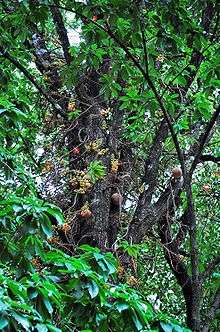Couroupita guianensis
Couroupita guianensis, known by a variety of common names including cannonball tree,[3] is a deciduous tree in the family Lecythidaceae. It is native to the tropical forests of Central and South America,[1] and it is cultivated in many other tropical areas throughout the world because of its beautiful, fragrant flowers and large, interesting fruits. Fruits are brownish grey.[4] There are medicinal uses for many parts of Couroupita guianensis,[5] and the tree has cultural and religious significance in India.[5]
| Couroupita guianensis | |
|---|---|
 | |
| Scientific classification | |
| Kingdom: | Plantae |
| Clade: | Tracheophytes |
| Clade: | Angiosperms |
| Clade: | Eudicots |
| Clade: | Asterids |
| Order: | Ericales |
| Family: | Lecythidaceae |
| Genus: | Couroupita |
| Species: | C. guianensis |
| Binomial name | |
| Couroupita guianensis | |
| Synonyms | |
| |
Description
Couroupita guianensis is a tree that reaches heights of up to 35 metres (110 ft).[6] The leaves, which occur in clusters at the ends of branches, are usually 8 to 31 centimeters (3 to 12 inches) long, but can reach lengths of up to 57 centimeters (22 inches).[6] The flowers are born in racemes up to 80 centimeters (31 inches) long. Some trees flower profusely until the entire trunk is covered with racemes. One tree can hold as many as 1000 flowers per day. The flowers are strongly scented, and are especially fragrant at night[7] and in the early morning.[6] They are up to 6 centimeters (2.5 inches) in diameter, with six petals, and are typically brightly colored, with the petals ranging from shades of pink and red near the bases to yellowish toward the tips. There are two areas of stamens: a ring of stamens at the center, and an arrangement of stamens that have been modified into a hood.[6]
The fruits are spherical with a woody shell and reach diameters of up to 25 centimeters (10 inches), which give the species the common name "cannonball tree". Smaller fruits may contain about 65 seeds, while large ones can hold as many as 550.[6] One tree can bear 150 fruits. The fruits take up to a year to mature in most areas, sometimes as long as 18 months. The fruit flesh is white and turns blue upon oxidation, a reaction with air.
Scientific and common names
The tree was named Couroupita guianensis by the French botanist Jean Baptiste Christophore Fusée Aublet in 1775. Common names in other languages include many translations of the English cannonball tree. Common names include abricó-de-macaco (Portuguese), coco sachapura (Colombia, Panama), bala de cañón (Costa Rica, Panama), kanonskogelboom (Dutch), arbre à boulet de canon (French), kouroupitoumou (French Guiana), 'Nagalinga Ful' (or nagalingam) (Bengali), Nagalinga Pushpa (Kannada), Nagalingam or Lingam (Tamil), నాగమల్లి Nagamalli (Telugu), sala (Indonesia), granadillo de las huacas (Panama), ayahuma (Peru), and boskalebas (Suriname).[8] It is also called Naaga danthee in Malayalam and Nagakeshara ନାଗକେଶର in Odia.
Pollination
Although the flowers lack nectar, they are very attractive to bees, which come for the pollen. The flowers produce two types of pollen: fertile pollen from the ring stamens, and sterile pollen from the hood structure. The pollinators must work their way between the two areas of stamens as they gather the pollen. The carpenter bee Xylocopa brasilianorum is a common pollinator of cultivated trees in Rio de Janeiro, just outside the tree's native range. Other carpenter bees such as Xylocopa frontalis, as well as wasps, flower flies, and bumblebees, are also known to visit the flowers.[6]
Dispersal
The seeds are dispersed by animals that feed on the fruits. When the fruits fall to the ground, the hard, woody shell usually cracks open, exposing the pulp and seeds. Fruits that remain whole may be broken open by animals such as peccaries. Many animals feed on the pulp and seeds, including peccaries, the paca, and domestic chickens and pigs. The seeds are covered with trichomes which may protect them as they pass through the animals' digestive systems.[6]
Human uses
Couroupita guianensis is planted as an ornamental for its showy, scented flowers, and as a botanical specimen for its interesting fruit.[6]
The fruit is edible, but is not usually eaten by people because, in contrast to its intensely fragrant flowers, it can have an unpleasant smell.[8] It is fed to livestock such as pigs and domestic fowl.[6]
There are many medicinal uses for the plant. Native Amazonians use extracts of several parts of the tree to treat hypertension, tumors, pain, and inflammation. It has been used to treat the common cold, stomachache, skin conditions and wounds, malaria, and toothache.[5]
Cultural significance
In India, the tree introduced from South America has been adopted as sacred to Hindus, who believe its hooded flowers look like the nāga, and it is grown at Shiva temples.[5]
Galleries
_young_leaves_in_Hyderabad%2C_AP_W_IMG_6606.jpg) leaves
leaves- buds
- flowers
- fruits
- fallen fruit and dried fruit rind
References
- Mitré, M. 1998. Couroupita guianensis. In: IUCN 2012. IUCN Red List of Threatened Species. Version 2012.2. Downloaded on 30 May 2013.
- "Couroupita guianensis Aubl. — the Plant List".
- Chisholm, Hugh, ed. (1911). . Encyclopædia Britannica (11th ed.). Cambridge University Press.
- "Couroupita guianensis". Germplasm Resources Information Network (GRIN). Agricultural Research Service (ARS), United States Department of Agriculture (USDA). Retrieved 21 December 2017.
- Al-Dhabi, N. A., et al. (2012). Antimicrobial, antimycobacterial and antibiofilm properties of Couroupita guianensis Aubl. fruit extract. BMC Complementary and Alternative Medicine 12 242–50.
- Prance, G. T. & S. A. Mori. Couroupita guianensis Aubl. New York Botanical Garden. 2013.
- Brown, S. H. Couroupita guianensis. University of Florida IFAS Extension.
- Lim, T. K. Couroupita guianensis. In: Edible Medicinal and Nonmedicinal Plants. Volume 3: Fruits. Springer. 2012.
External links
| Wikimedia Commons has media related to Couroupita guianensis. |

